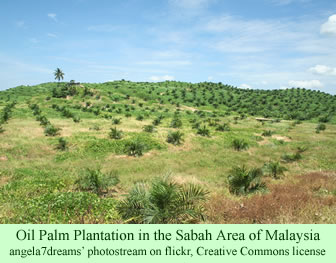While some Semai emphasize retaining their ties to their natural forests, others accept, and value, forest-destructive practices that will secure for them the benefits of the consumer economy. A review in this website last Thursday discussed a journal article that analyzes the importance of the forest environment to three Semai communities in the hills just east of the town of Tapah, in Malaysia’s Perak state.
Also last week, a major Malaysian newspaper published a report about a different Semai community, this one located about 16 miles northwest of Tapah—farther away from the mountains and the original forest environment. It is a community where the villagers have converted much of their lands to oil palm plantations. They are evidently happy that they now have a lot of disposable income.
Whether they are pleased that they no longer have any forests, the journalist for the The Star, Sheela Chandran, does not say. She was impressed that the roads into Kampung Chenderong Kelubi had been paved for decades and that the community had electricity and access to water. There is a primary school for the 170 children in the village as well as a kindergarten facility for the preschool kids. Education beyond the primary level is available in nearby towns.
Over 1,300 people live in the community, most of whom have brick houses with modern appliances and furnishings, including flat screen TVs, hi-fi systems, plush furniture, and air conditioning. Their kitchens include food processors, stand-alone freezers, and water filters. Teenagers are well dressed, stylish consumers with their tablets and smartphones. Pick-up trucks, cars, and motorcycles are parked outside most of the homes.
Ms. Chandran intends a compliment when she writes that the “village could easily be mistaken as a developed Malay settlement in Perak.” The land was first cleared for paddy farming during the years of the British rule; in the late 1950s, the villagers planted rubber trees, and in the 1980s they invested in oil palm plantations. They are making a lot of money off of their latest venture.
The reporter talks with villager Alang Chot, a 59-year old mother of four, who owns about 1 hectare of oil palms. She says that the villagers own between one and five hectares per family, and if they work hard, they can make a lot of money. Like other villagers, she has taken on additional jobs to earn extra funds. She has become a skilled tailor, and makes clothing to fit her customers. Ms. Chandran finds that her prices are quite reasonable compared to hand-made clothing in Malaysian cities. Ms. Chot also runs a catering business.
She tells the writer that she and the other Semai in the village are striving to improve their living standards in order to keep up with other communities. “While palm oil is our lifeline, we are constantly thinking of ways to earn extra income. Our needs have become complex, as we need extra resources to fulfil our wants.”
Another villager, Azmi Dongkin, 44, manages four hectares of oil palms and runs a family business, a shop in the village. He admits it is challenging running the shop and doing the work on his plantation, but he is happy to have the funds all the work brings in. He is earning money that will help pay to educate his children, and he saves some so he and his family can take vacations.
Ngah Uda, 52, tells the reporter that he catches giant freshwater prawns from a pond in the village in order to supplement the income he gains from his oil palm plantation. He feels that by managing his time well and by working hard, he is able to earn extra income. He views his work catching prawns more as a hobby than a job—he likes rowing his boat and enjoying the scenery.
Ms. Chandran would agree, for during her drive to Kampung Chenderong Kelubi, she noticed the lush green scenery along with the oil palm plantations. One might suspect that these Semai are far enough removed, both in space and time, from a forest-based existence that some of the traditions still held by the people in the hills 20 miles to the east may no longer mean as much to them.
